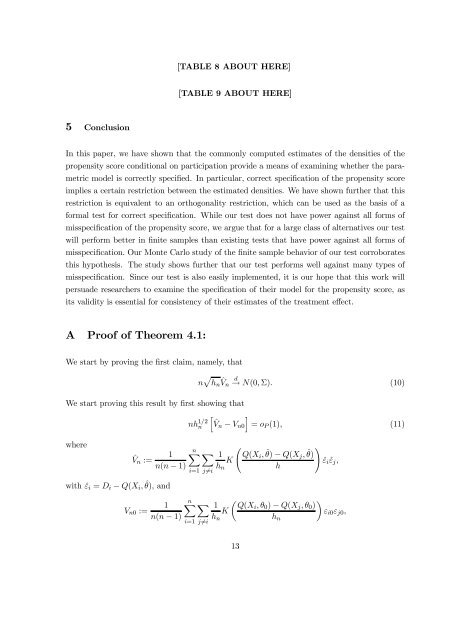On the Identification of Misspecified Propensity Scores - School of ...
On the Identification of Misspecified Propensity Scores - School of ...
On the Identification of Misspecified Propensity Scores - School of ...
Create successful ePaper yourself
Turn your PDF publications into a flip-book with our unique Google optimized e-Paper software.
5 Conclusion<br />
[TABLE 8 ABOUT HERE]<br />
[TABLE 9 ABOUT HERE]<br />
In this paper, we have shown that <strong>the</strong> commonly computed estimates <strong>of</strong> <strong>the</strong> densities <strong>of</strong> <strong>the</strong><br />
propensity score conditional on participation provide a means <strong>of</strong> examining whe<strong>the</strong>r <strong>the</strong> para-<br />
metric model is correctly specified. In particular, correct specification <strong>of</strong> <strong>the</strong> propensity score<br />
implies a certain restriction between <strong>the</strong> estimated densities. We have shown fur<strong>the</strong>r that this<br />
restriction is equivalent to an orthogonality restriction, which can be used as <strong>the</strong> basis <strong>of</strong> a<br />
formal test for correct specification. While our test does not have power against all forms <strong>of</strong><br />
misspecification <strong>of</strong> <strong>the</strong> propensity score, we argue that for a large class <strong>of</strong> alternatives our test<br />
will perform better in finite samples than existing tests that have power against all forms <strong>of</strong><br />
misspecification. Our Monte Carlo study <strong>of</strong> <strong>the</strong> finite sample behavior <strong>of</strong> our test corroborates<br />
this hypo<strong>the</strong>sis. The study shows fur<strong>the</strong>r that our test performs well against many types <strong>of</strong><br />
misspecification. Since our test is also easily implemented, it is our hope that this work will<br />
persuade researchers to examine <strong>the</strong> specification <strong>of</strong> <strong>the</strong>ir model for <strong>the</strong> propensity score, as<br />
its validity is essential for consistency <strong>of</strong> <strong>the</strong>ir estimates <strong>of</strong> <strong>the</strong> treatment effect.<br />
A Pro<strong>of</strong> <strong>of</strong> Theorem 4.1:<br />
We start by proving <strong>the</strong> first claim, namely, that<br />
n hn ˆVn d → N(0, Σ). (10)<br />
We start proving this result by first showing that<br />
<br />
ˆVn − Vn0 = oP (1), (11)<br />
where<br />
ˆVn :=<br />
with ˆεi = Di − Q(Xi, ˆ θ), and<br />
Vn0 :=<br />
1<br />
n(n − 1)<br />
1<br />
n(n − 1)<br />
nh 1/2<br />
n<br />
n<br />
<br />
1 Q(Xi,<br />
K<br />
ˆ θ) − Q(Xj, ˆ <br />
θ)<br />
ˆεiˆεj,<br />
h<br />
hn<br />
i=1 j=i<br />
n <br />
<br />
1 Q(Xi, θ0) − Q(Xj, θ0)<br />
K<br />
hn<br />
i=1 j=i<br />
13<br />
hn<br />
εi0εj0,
















